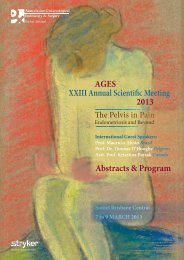to Obstetric Trauma Pelvic Floor Repair Surgical Essentials - AGES
to Obstetric Trauma Pelvic Floor Repair Surgical Essentials - AGES
to Obstetric Trauma Pelvic Floor Repair Surgical Essentials - AGES
You also want an ePaper? Increase the reach of your titles
YUMPU automatically turns print PDFs into web optimized ePapers that Google loves.
<strong>AGES</strong><br />
<strong>Pelvic</strong> <strong>Floor</strong><br />
Symposium &<br />
Workshop XII<br />
2011<br />
<strong>to</strong><br />
<strong>Obstetric</strong> <strong>Trauma</strong><br />
<strong>Pelvic</strong> <strong>Floor</strong> <strong>Repair</strong><br />
<strong>Surgical</strong> <strong>Essentials</strong><br />
20<br />
This cohort represents 9.7% of local Apogee cases and 7.95% of<br />
local Perigee cases and approximately 3.8% of local Prolift cases.<br />
OTHER SURGICAL DATA<br />
- 1 woman had a concomitant hysterec<strong>to</strong>my. 1 had her uterus<br />
conserved and 1, who had previously undergone a sub<strong>to</strong>tal<br />
hysterec<strong>to</strong>my, had her cervix conserved.<br />
- Descriptions of prolapse severity at the time of mesh repair is<br />
generally of a poor standard and current grading/staging systems<br />
have not been used. However there is documentation of some<br />
degree of apical prolapse in at least half of the women at the time<br />
of their mesh repairs.<br />
- Notably 3 women had previously participated in surgical<br />
workshops; 1 Perigee, 1 Ant and Post Prolift and 1 laparoscopic<br />
pelvic floor repair who had subsequently undergone an Apogee<br />
and Perigee.<br />
- There were many other previous surgeries, gynaecological and<br />
otherwise, and co-morbidities in this cohort.<br />
Time interval <strong>to</strong> presentation with apical prolapse:<br />
• range 2 weeks - 26 months, median 5.5 months, mean 8.5<br />
months.<br />
Apical prolapse grading:<br />
• range grade 1 <strong>to</strong> grade 4, median grade 3.<br />
• 1 woman had a concomitant rectal intussusception<br />
FURTHER MANAGEMENT:<br />
laparoscopic sacrocolpopexy- 5 (4 by the author)<br />
lap converted <strong>to</strong> open SCP- 4 (4 by the author)<br />
open sacrocolpopexy- 1<br />
lap sacrocolporec<strong>to</strong>pexy- 1 (by the author and a colorectal surgeon)<br />
abandoned SCP<br />
1 (by the author’s fellow and the author)<br />
Cube Pessary 1<br />
awaiting SCP 1<br />
3 of the 4 cases converted <strong>to</strong> open sacrocolpopexy had previously<br />
undergone anterior and posterior mesh repairs. Much reduced vaginal<br />
mobility was noted in these cases. Other fac<strong>to</strong>rs for conversion<br />
included obesity, adhesions and excessive CO 2<br />
absorption.<br />
Of the 6 successful laparoscopic procedures, only 1 had previously<br />
undergone anterior and posterior mesh repairs. This case was<br />
described as “very difficult”.<br />
One sacrocolpopexy was abandoned intra-operatively following a<br />
cys<strong>to</strong><strong>to</strong>my (repaired laparoscopically) and identification of a grossly<br />
enlarged bladder extending over the vaginal vault and filling the<br />
pouch of douglas with dense adhesions <strong>to</strong> the rectum. Access was<br />
insufficient <strong>to</strong> allow safe dissection and completion of the surgery.<br />
She had previously undergone anterior and posterior mesh repair<br />
and is presently being considered for colpocleisis.<br />
1 of the cases converted from laparoscopic <strong>to</strong> open SCP was<br />
complicated by an entero<strong>to</strong>my identified the following day. This was<br />
managed by a small bowel resection and re-anas<strong>to</strong>mosis. The mesh<br />
was initially left in place but was later removed due <strong>to</strong> concern about<br />
infection. Culture of the mesh was negative. Despite removal of the<br />
mesh the prolapse has not recurred.<br />
OUTCOMES: All completed sacrocolpopexies were ana<strong>to</strong>mical and<br />
symp<strong>to</strong>matic successes, although two women have subsequently<br />
developed recurrent cys<strong>to</strong>coeles, with the bladder prolapsing in front<br />
of the distal edges of their perigee and anterior prolift respectively.<br />
One of these is asymp<strong>to</strong>matic and one is considering further<br />
surgery. Ultrasound images from one of these cases are available for<br />
presentation.<br />
SUMMARY OF FINDINGS: Apical prolapse following vaginal mesh<br />
repair is not an uncommon phenomenon in our population.<br />
Presentation is often very early, within the first 12 months.<br />
It appears <strong>to</strong> be more common following Apogee and Perigee<br />
compared <strong>to</strong> Prolift.<br />
Sacrocolpopexy appears <strong>to</strong> be an effective management although<br />
there is a high rate of conversion from laparoscopic <strong>to</strong> open surgery,<br />
particularly in those women who have previously undergone anterior<br />
and posterior mesh repairs (the authors rate of conversion from<br />
laparoscopic <strong>to</strong> open sacrocolpopexy is otherwise less than 5%).<br />
This may be related <strong>to</strong> obesity and adhesions from previous surgery<br />
but considerably reduced vaginal mobility was noted in all cases and<br />
may be a fac<strong>to</strong>r.<br />
There is a higher than normal rate of intra-operative complications<br />
in this group.<br />
Women who have previously participated in surgical workshops are<br />
well represented in this cohort.<br />
DISCUSSION: Fac<strong>to</strong>rs potentially involved in the development<br />
of these prolapses include surgical fac<strong>to</strong>rs, such as poor case<br />
selection or technique, patient fac<strong>to</strong>rs, such as predisposition <strong>to</strong><br />
recurrent prolapse and/or obesity, and device fac<strong>to</strong>rs, such as<br />
mesh kits not providing adequate apical/level 1 support. Whilst<br />
some of these prolapses may represent genuine de novo prolapse<br />
in another compartment it is likely that in some cases the initial<br />
mesh procedures may not have been the ideal choice of operations,<br />
particularly for those in whom there was evidence of apical prolapse

















